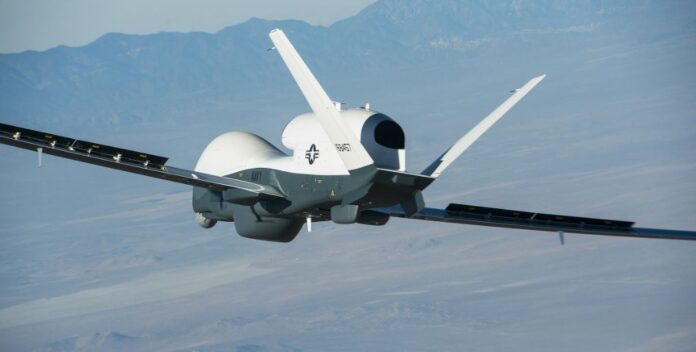TOKYO — The United States is set to deploy advanced MQ-4C Triton reconnaissance drones to Kadena Air Base in Okinawa, Japan, within weeks, Japan’s Defense Minister Gen Nakatani announced on April 8, 2025. The move, aimed at strengthening intelligence-sharing between the U.S. and Japan, comes as China intensifies its military presence in the East China Sea, heightening regional tensions.
The MQ-4C Triton, with its 40-meter wingspan, offers superior surveillance capabilities compared to the MQ-9 Reaper drones stationed at Kadena since 2023. Designed for long-endurance missions, the Triton can soar at higher altitudes and monitor vast expanses, making it a critical asset for tracking maritime and aerial activities. Nakatani emphasized that the deployment, which has no set end date, will enhance the Japan-U.S. alliance’s ability to respond to evolving security challenges.
Also Read: China Reportedly Plans Six Major Countermeasures to U.S. Tariffs
Okinawa’s strategic location—close to disputed areas like the Senkaku Islands and Taiwan—positions it as a linchpin in the alliance’s surveillance network. The deployment follows a successful five-month trial of the Triton in the region last year, signaling a long-term commitment to bolstering defenses against China’s growing assertiveness. Beijing has ramped up naval and air operations near Japan, prompting concerns over territorial ambitions and regional stability.
The indefinite stationing of these drones underscores a deepening military partnership between Tokyo and Washington as they counter China’s influence in the Indo-Pacific. While the U.S. has not commented on specific operational plans, analysts see the move as a clear message to Beijing amid ongoing disputes. For Okinawa, already a hub of U.S. military activity, the arrival of the Tritons marks another step in its pivotal role in East Asian security dynamics.
Key Points:
- Deployment Announcement: Japan’s Defense Minister Gen Nakatani announced on April 8, 2025, that the U.S. will deploy MQ-4C Triton reconnaissance drones to Kadena Air Base in Okinawa within weeks.
- Drone Capabilities: The MQ-4C Triton, with a 40-meter wingspan, can fly higher and cover wider areas than the MQ-9 Reaper drones already at Kadena since 2023, enhancing surveillance reach.
- Strategic Purpose: The deployment aims to improve Japan-U.S. intelligence coordination in response to China’s increasing military activity in the East China Sea.
- Indefinite Duration: Unlike a previous five-month trial in 2024, this deployment has no set end date, indicating a long-term commitment.
- Regional Context: Okinawa’s proximity to flashpoints like the Senkaku Islands and Taiwan makes it a vital hub in the alliance’s surveillance network.
- China Tensions: The move comes amid escalating tensions with China, which has intensified naval and air operations near Japan, raising concerns over regional stability.
- Alliance Strengthening: The deployment reflects a deepening U.S.-Japan military partnership to counter China’s growing influence in the Indo-Pacific.



